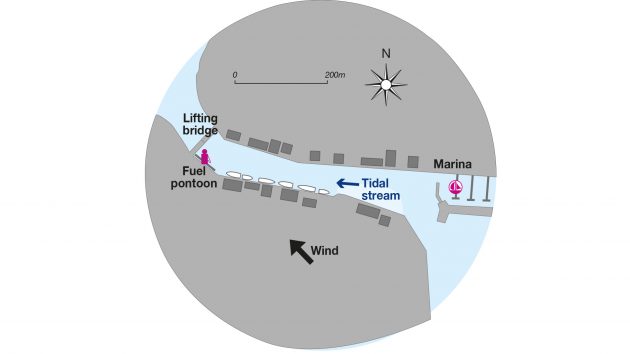James Stevens considers a problem sent in by a Yachting Monthly reader who wants to know whether to sail to a fuel dock or wait it out?
John is skipper of a Beneteau Oceanis 34 sailing back to the UK from a holiday in France with two crew. When they left France, the forecast was variable becoming SE F4 to 5.
John wanted to get away early so decided that with a favourable wind, having only a quarter of a tank of fuel would be OK. That turned out to be a mistake. There was no wind on the way across and they ran out of fuel about 20 miles from the English coast, but fortunately the wind has now freshened to the forecast SE Force 4.
It is 2300 and John is sailing into a harbour on the South Coast. He has booked and paid for a berth at the marina. About 500m further up the harbour from the marina is a serve- yourself fuel pontoon on the port side which is open all night.
The fuel dock is very close to a lifting bridge which is closed for yachts at night. The tide is flooding and the wind is blowing diagonally off the fuel pontoon towards the bridge. Although this area is illuminated by nearby street lights it is surrounded by buildings which give disturbed wind on the water.
There are plenty of free moorings and also places to anchor. John is weighing up whether to pick up a mooring and call for a tow in the morning, or sail to the fuel pontoon. What would you do?

Should you sail to a fuel dock or wait it out?
The safe but expensive option is to moor or anchor and wait for the marina launch in the morning.
Sailing to the fuel pontoon is possible. Fortunately the harbour should be quiet at that time of night so there should be very few other craft to hinder the boat handling.
First John should sail to a position where he can see up the harbour to the bridge to determine the strength and direction of the wind and whether the pontoon is free. Then he could sail back out into clear water to prepare the fenders and warps.
If the buildings around are blanketing the wind then the manoeuvre is impossible, but if there is wind there are two options. In a fresh breeze, jib alone is safer because it is easier to slow down on a broad reach. It’s also vital to have enough speed to make the turn into the wind and tide at the bridge.
The other option for John is to keep the main up to make as much use of the wind as possible, but the halyard will have to be ready to release as soon as the yacht turns into the wind. The turn, which is near the bridge, needs to be very tight to reduce the boat speed to come alongside. Judging that turn is skilful and John needs to know his boat well because he only really has one chance to come alongside.
Enjoyed reading this?
A subscription to Yachting Monthly magazine costs around 40% less than the cover price.
Print and digital editions are available through Magazines Direct – where you can also find the latest deals.
YM is packed with information to help you get the most from your time on the water.
-
-
- Take your seamanship to the next level with tips, advice and skills from our experts
- Impartial in-depth reviews of the latest yachts and equipment
- Cruising guides to help you reach those dream destinations
-
Follow us on Facebook, Twitter and Instagram.





